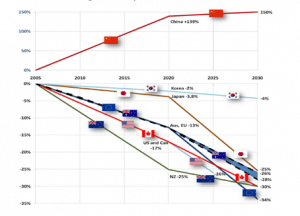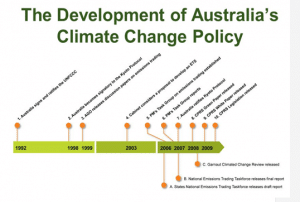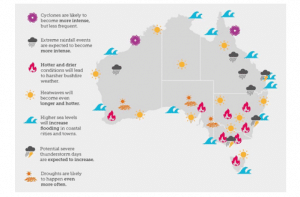CASE STUDY: SOCIAL SCIENCES POLICY ANALYSIS 2020
CLIMATE CHANGE POLICY
This assessment is based on the critical analysis of the climate change policy or environmental policy by identifying the social, economic, political and historical factors that enforced the execution and development of this policy. At the same time, this assignment also analyzes the relationship and intersection between different aspects of the policy-making process including power and interests in relation to the climate change policy.
The environmental policy of Australia is located in the climate change area that addresses climate change issues and ensures energy security and affordability. Under this policy, it is ensured by the government of Australia to reduce greenhouse gas emissions and increase the contribution of the business, individual and community and households to reduce these gases emissions to protect the environment. This policy area also ensures that everyone is contributing to environmental protection as efforts made by everyone make a difference in making the environment safe. This policy is oriented to achieve Australia’s 2030 target and Paris Agreement commitments (Australian Government, 2018). The government is committed to handling the issues related to climate change. With the help of this policy, Australia plays an important role in the reduction of emissions and maintenance of a strong economy by ensuring the low carbon emissions.
The climate change policy is effective to reduce Australia’s emissions by achieving the 2020 emissions reduction target and ensuring the execution of a long-term framework. This policy incorporates opportunities and challenges that can be possible in reducing emissions sector wise. This policy also includes its effects on employment, investment, trade competitiveness and households of Australia. This also covers the integration of climate change and energy policy with other policies to achieve national targets. This policy also guides for the long-term emissions reduction goal post-2030 (Australian Government, 2018).
Social, economic, political and historical factors
Social factors: Social factors play the major role in execution and development of climate change policy as it has been mandatory for the government to execute and develop this policy due to increasing concerns of the society or community. Currently, the increasing concerns of the public towards the environmental protection have enforced the government to adopt the climate change policy and make changes in this policy regularly to reduce the carbon emission in the country. The people have started to consume green and organic products and like to purchase the products of the firms which adopt better practices in relation to climate protection (Adger et al., 2013). Therefore, social factors in terms of public concerns played an important role in the execution and development of this policy.
Apart from this, society also expects from the government that it needs to adopt better policies that could ensure the production of the products that are less harmful to the environment as it is required to consider the business aspects in the development of the climate change policy. This also enforced the government to consider the business aspects in the climate change policy. In addition, society or community also have power and interest to enforce this policy because it is oriented towards the health aspects due to increasing diseases in Australia (Teixeira et al., 2013). So, it had been mandatory for the Australian government to consider this policy to ensure the safe environment to avoid diseases and make people healthy.
Economic factors: Several economic factors such as human health costs, expenses on the protection of biodiversity and coastal zones, agriculture and food security, water resources, etc. are significant in execution and development of the climate change policy. It is because climate change may have a significant impact on all these economic factors that raises the need for the government to adopt a change management policy. It is because climate change has an impact on the health of people that raise the costs of climate change in the country affecting the economy. At the same time, the climate change also adversely impacts the agriculture sector by changing the rain patterns that cause difficulty for the country to manage economic conditions based on agriculture system (Eisenack et al., 2014). So, the influence of climate change on the agriculture sector also enforced the government of Australia to implement and develop the climate change policy.

(Source: Sustainable Freight, 2018)
In addition, the adverse climate changes also impact other sectors like livestock, fisheries, forestry, energy, insurance and tourism industries that raise the need for the adoption of the climate change in the country to control the economy. Other sectors like infrastructure including roads, railways, and airports are also subject to climate change as they need high maintenance and renewal that may be affected by the changing climatic conditions. In addition, the impact of climate change in freshwater resources like loss of aquatic species and household flooding also stimulated the adoption and development of the climate change policy in Australia (Wheeler, Zuo and Bjornlund, 2013). The costs to the country may be possible due to infrastructure investments for the protection against floods and droughts that raised the need for the implementation and development of the climate change policy in the country.

Political factors: The increasing concerns of the government of different countries across the globe have enforced the execution and development of the climate change policy. The government of different developing and developed countries has announced the initiatives for reduction of carbon emission that raised the need for the countries to adopt the climate change policy at the national level. In addition, the Intergovernmental Panel on Climate Change (IPCC) is the international organization for assessing the climate change and providing the scientific information and technical guidance to the United Nations Framework Convention on Climate Change (UNFCCC), its Kyoto Protocol and Paris Agreement (Australian Government, 2018).
The involvement of this body also facilitated the execution and development of the climate change policy in Australia. The signing of the Kyoto Protocol in December 2007 also raised the need to adopt the climate change policy in Australia. It is because this organization provides practical guidance to support to develop the treaties related to the international climate change and strategies to handle the greenhouse gas emissions (Bain et al., 2012). From the surveys in Australia and across the countries, it can be recognized that the pertinence of issue of acceptance of climate change science is the key perspective in causing the political action on climate change.
Historical factors: Historical factors include the incidents and events that have been happened in past and enforced the country to adopt the climate change policy to address the issues. During 2002-2009, the prolonged drought and summer bushfires and high temperatures in many areas caused the public concerns regarding climate change. It also enforced the government to adopt such policy that could be effective to mitigate these issues occurred in history. Apart from this, in recent years, the rain patterns have been changed considerably that have also raised the need to make a change in policies to consider the climate change on priority (Parliament of Australia, 2018). It is because rain patterns have caused the severe water shortage and flooding in different regions of Australia that facilitated the implementation and the development of the new policy.
At the same time, the melting of glaciers has also caused the flooding and soil erosion in the country that enforced the government to take initiatives for handling the climate change issues. The changes in the distribution of disease vectors have also increased the number of people at risk from diseases like malaria and dengue fever. The increasing number of patients in recent years has been an important factor that also raised the need for adopting the climate change policy (Broto and Bulkeley, 2013). In addition, the rising temperature over the period has shifted in crop growing seasons which affected the food security that made it a priority for the government to address the climate change issues through the relevant policy.
There are several factors that play an important role in the formulation and development of climate change in current. All these factors are also considered while developing and making changes in the existing climate change policy. The increasing temperature level and changing climatic conditions including rain patterns and drought conditions are the factors that are considered in the climate change policy of the country. Apart from this, different factors including socio-economic opportunities, environmental, technological and institutional factors are also considerable currently in developing the climate change policy. In addition, emission projections and forecasts are significant factors that play an important role in developing the climate change policy (Parliament of Australia, 2018). With the help of the projections, it becomes easy for the authorities and organizations to consider the new targets each time and update the policy accordingly to achieve the desired targets.
The global reports that provide the measurement of the greenhouse gases at the country level are also considered as key factors to implement and develop the climate change policy. For example, the department of the environment and energy published the national greenhouse accounts of the country that is helpful to track the national emissions over the period and consider it in the formulation of the change management policy. Moreover, different types of risks are also considered currently to develop the climate change policy (Field, 2014).
In relation to this, infrastructure risk including the physical effects of the climate change on assets and investments and associated costs is the considerable factor that plays an important role in implementing the developing the climate change policy (Schäfer, Ivanova and Schmidt, 2014). Furthermore, the planning and policy risk like regional planning directions and regulated industry standards are also considered before making any change in climate policy. It is because this helps to avoid any extra cost on changing the plans and policy. Apart from this, market and competitiveness risk including the loss of productivity and changing markets are significant in climate change policy due to their relative importance to the business and economy of the country (Peters et al., 2012). Litigation risks related to the property insurance and loss of the business due to climate change are considerable in the climate change policy currently due to associated costs of the loss. Additionally, environmental risks including water resources, reduce pollination, specifies loss and clashes between rolling easements and urban development are the considerable factors that are considered in the climate change policy currently (Rickards and Howden, 2012). It is because of the significant impact of climate change is on the environment as it is crucial for the government authorities to consider environmental aspects regularly to update the climate change policy.

(Source: The Guardian.com 2017)
The limited resources and their availability with the decreasing number of natural resources due to climate change play a significant role in deciding the aspects of the climate change policy. Besides, community risk is a considerable current factor that is valuable in current climate change policy of the country (Bulkeley, 2013). It is because climate change has a significant impact on communities including youths, socially isolated and indigenous Australians. In addition, it is also evident from the current climate change policy, it is crucial to consider the community risk as the impact of climate change, associated adaptation, and mitigation approaches are valuable for the government to make the climate change policy (Pittock, 2017). The government of Australia considers all these factors while developing and executing the current climate change policy. So it is mandatory for the government authorities to consider this factor at a significant level to improve the climate change policy at the regular level. Apart from this, political factors are also considered because politicians also face interactions and specific stances from other politicians of the world (Fielding et al., 2012). For maintaining good relations with other countries and trade relations, it is mandatory for the government to handle these issues properly while making the climate change policy of the country.
Factors that have been overlooked
On the review of the current climate change policy of Australia, it can be stated that the country is on track to achieve the target of emission reduction by 5% below 2000 levels as part of the Paris agreement but it will be difficult to achieve the goal of 26-28% by 2030. It is because some factors that are being ignored in the current climate change policy of the country. In this, the lack of review and refine cycle is a significant factor that has been ignored in the implementation and development of the current climate change policy (Nyberg, Spicer, and Wright, 2013). There is no update on the emission reduction targets every five years under the Paris agreement. The introduction of this cycle will be significant to get guidance and directions to achieve the goals efficiently. Apart from this, ignorance of the examination of electricity generation is also a significant factor that should have been considered in the implementation and development of the climate change policy (Kiem, 2013). It is because such type of examination can be significant to consider the best design and implementation methods for accomplishing the emission reduction targets. Under this, it will be ensured to reduce the emission by the energy retailers and big polluters. Apart from this, the safeguard mechanism is also ignored in the formulation of the climate change policy. The Safeguard Mechanism is effective to measure and manage the emission levels by the biggest business polluters that need to be considered to achieve the emission reduction targets by 2030. Additionally, the Australian government has not allowed yet to the companies to compensate their carbon emissions through purchasing of the global permits. Trade international units can be a better policy to improve the carbon footprint of the country (Bulkeley and Newell, 2015). Moreover, it is also crucial to plan a long-term climate change policy as it is required for the government to consult with [public and experts to formulate goals for emission reduction in long-term.
Based on the above discussion, it can be concluded that the climate change policy of Australia is quite good to address climate change issues and improve the environmental conditions to bring socio-economic development. There are a significant power and interest of social, economic, historical and political factors on the implementation and development of the climate change policy of Australia. It is because all these factors have played an important role in the execution and development of this policy. Apart from this, it can also be summarized that some factors like socio-economic opportunities, environmental, technological and institutional factors, emission projections, changing climatic conditions, publications and several types of risks including infrastructure risk, environmental risks, planning, and political risk and community risks are considered in the execution and development of the climate change policy currently.
Adger, W.N., Barnett, J., Brown, K., Marshall, N. and O’brien, K., 2013. Cultural dimensions of climate change impacts and adaptation. Nature Climate Change, 3(2), p.112.
Australian Government 2018. Climate Change. [Online] Available at: http://www.environment.gov.au/climate-change [Accessed: 2 November 2018]
Bain, P.G., Hornsey, M.J., Bongiorno, R., and Jeffries, C., 2012. Promoting pro-environmental action in climate change deniers. Nature Climate Change, 2(8), p.600.
Broto, V.C. and Bulkeley, H., 2013. A survey of urban climate change experiments in 100 cities. Global environmental change, 23(1), pp.92-102.
Bulkeley, H. and Newell, P., 2015. Governing climate change. Routledge.
Bulkeley, H., 2013. Cities and climate change. Routledge.
Eisenack, K., Moser, S.C., Hoffmann, E., Klein, R.J., Oberlack, C., Pechan, A., Rotter, M. and Termeer, C.J., 2014. Explaining and overcoming barriers to climate change adaptation. Nature Climate Change, 4(10), p.867.
Field, C.B. ed., 2014. Climate change 2014–Impacts, adaptation, and vulnerability: Regional aspects. Cambridge University Press.
Fielding, K.S., Head, B.W., Laffan, W., Western, M. and Hoegh-Guldberg, O., 2012. Australian politicians’ beliefs about climate change: political partisanship and political ideology. Environmental Politics, 21(5), pp.712-733.
Kiem, A.S., 2013. Drought and water policy in Australia: challenges for the future illustrated by the issues associated with water trading and climate change adaptation in the Murray–Darling Basin. Global Environmental Change, 23(6), pp.1615-1626.
Leonard, S., Parsons, M., Olawsky, K. and Kofod, F., 2013. The role of culture and traditional knowledge in climate change adaptation: Insights from East Kimberley, Australia. Global Environmental Change, 23(3), pp.623-632.
Nyberg, D., Spicer, A. and Wright, C., 2013. Incorporating citizens: corporate political engagement with climate change in Australia. The organization, 20(3), pp.433-453.
Parliament of Australia 2018. Australian climate change policy to November 2013: a chronology. [Online] Available at: https://www.aph.gov.au/About_Parliament/Parliamentary_Departments/Parliamentary_Library/pubs/rp/rp1516/ClimateChron [Accessed: 2 November 2018]
Peters, G.P., Andrew, R.M., Boden, T., Canadell, J.G., Ciais, P., Le Quéré, C., Marland, G., Raupach, M.R. and Wilson, C., 2012. The challenge to keep global warming below 2 C. Nature Climate Change, 3(1), p.4.
Pittock, A.B., 2017. Climate change: turning up the heat. Routledge.
Rickards, L. and Howden, S.M., 2012. Transformational adaptation: agriculture and climate change. Crop and Pasture Science, 63(3), pp.240-250.
Schäfer, M.S., Ivanova, A. and Schmidt, A., 2014. What drives media attention for climate change? Explaining issue attention in Australian, German and Indian print media from 1996 to 2010. International Communication Gazette, 76(2), pp.152-176.
Sustainable Freight 2018. [Online] Available at: http://www.sustainablefreight.com.au/policies-and-regulations/federal-climate-change-policy [Accessed: 2 November 2018]
Teixeira, E.I., Fischer, G., van Velthuizen, H., Walter, C. and Ewert, F., 2013. Global hot-spots of heat stress on agricultural crops due to climate change. Agricultural and Forest Meteorology, 170, pp.206-215.
The Guardian.com 2017. Australia facing climate disaster on its doorstep, government’s white paper warns. [Online] Available at: https://www.theguardian.com/environment/2017/nov/23/australia-facing-climate-disaster-on-its-doorstep-governments-white-paper-warns[Accessed: 2 November 2018]
Wheeler, S., Zuo, A. and Bjornlund, H., 2013. Farmers’ climate change beliefs and adaptation strategies for a water scarce future in Australia. Global Environmental Change, 23(2), pp.537-547.


